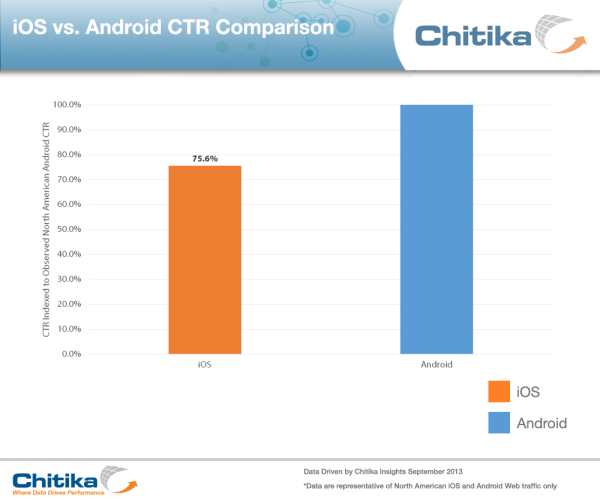Q3 2013 Roundup: Analyzing IOS 7 And The Evolving Mobile Landscape
A recent study published by Chitika Insights found that nearly 32% of North American iOS-based Web Traffic was generated by iOS 7 users just 48 hours following the release of the new OS on Wednesday, September 18. In a subsequent update published on September 25, data showed the iOS 7 adoption rate reaching more than […]
A recent study published by Chitika Insights found that nearly 32% of North American iOS-based Web Traffic was generated by iOS 7 users just 48 hours following the release of the new OS on Wednesday, September 18.
 In a subsequent update published on September 25, data showed the iOS 7 adoption rate reaching more than 50% in North America a week after its release. When compared with the adoption rate of Jelly Bean 4.3 in the same time period, the rapid rate of adoption for iOS 7 seems all the more impressive.
In a subsequent update published on September 25, data showed the iOS 7 adoption rate reaching more than 50% in North America a week after its release. When compared with the adoption rate of Jelly Bean 4.3 in the same time period, the rapid rate of adoption for iOS 7 seems all the more impressive.
By most measures, iOS 7 was the fastest software upgrade in history. The successful launch underscores some of the large scale trends developing across the traditional online landscape, including the fact that users are increasingly moving away from desktops, with a growing share of computing time spent on mobile devices.
With this in mind, Chitika Insights conducted a research study focusing on the respective click-through-rates (CTR) of North American mobile Web users, looking specifically at two of the most popular operating systems: iOS and Android.
The importance of correctly analyzing CTR cannot be overstated. It provides a way to quantify a customer’s initial response to a website. When an individual visits a website, the intent is not to click on advertisements, but to gather information about something in particular. CTR measures the proportion of visitors who took an action with respect to an advertisement, which led them to another page where they might purchase an item or engage with a product, brand, or service.
The data used in this study were drawn from ad impressions cataloged between September 12 and September 18, 2013 within the Chitika Advertising Network. In total, the sample was composed of tens of millions of online ad impressions from the U.S. and Canada. An index was created to graphically represent the data — 100% refers to Android, where the highest CTR was measured. If the other data point is 70%, for instance, that means that the observed CTR from that operating system’s visitors is 70% of the CTR as compared to the peak.

Based on the data, it was observed that Android users exhibit a higher CTR on average than iOS users. More precisely, the CTR for an average iOS user is 24.4% less than that of an average Android user.
For the purpose of this research, CTR was defined as the total number of clicks divided by the total number of impressions, for each operating system. Only Android and iOS operating systems were considered, based on their dominance of the mobile OS market.
For marketers and advertisers, it’s important to note that despite CTR differences, both platforms present significant revenue opportunities. In our previous study on this subject from December 2012, iOS users were slightly more likely than Android users to click on ads. Since that time, Android manufacturers have unveiled both tablets and smartphones that largely match, and in some cases exceed, the functionality of Apple’s mobile products. It’s possible that this new stream of comparable devices has broadened Android’s appeal, and changed what constitutes “average user behavior” from its users.
Looking at similar research on the topic, MoPub (pdf) also released monthly CTR averages from January 2013 to March 2013. Their data shows that ads served on an iOS platform had a “healthy performance advantage.” There is an important difference between their research and what is outlined above. The impressions in MoPub’s data are measured by the number of auction bids, thus, the data cannot be considered a random sample. (A sample is not considered random if it is collected based on certain factors. In this case, bidding on traffic that is most monetizable.)
Regardless of the source, the growth of mobile computing presents incredible opportunities for marketers and advertisers. Even with the expected future loss of third-party cookies and search referrer data, the use of big data and analytics within the market will help in honing in on the set of consumers who possess characteristics that make them most valuable to marketers.
In the meantime, these statistics point to Android having evolved into an even more attractive platform for advertisers in the mobile space. However, engineering challenges need to be kept in mind, particularly in regard to fragmentation within the Android ecosystem. Devices come in a variety of screen sizes and resolutions, and unlike iOS, many users’ devices run older versions of Android. Marketers should carefully optimize campaigns to best serve this wide range of users.
Contributing authors are invited to create content for MarTech and are chosen for their expertise and contribution to the search community. Our contributors work under the oversight of the editorial staff and contributions are checked for quality and relevance to our readers. MarTech is owned by Semrush. Contributor was not asked to make any direct or indirect mentions of Semrush. The opinions they express are their own.
Related stories
New on MarTech